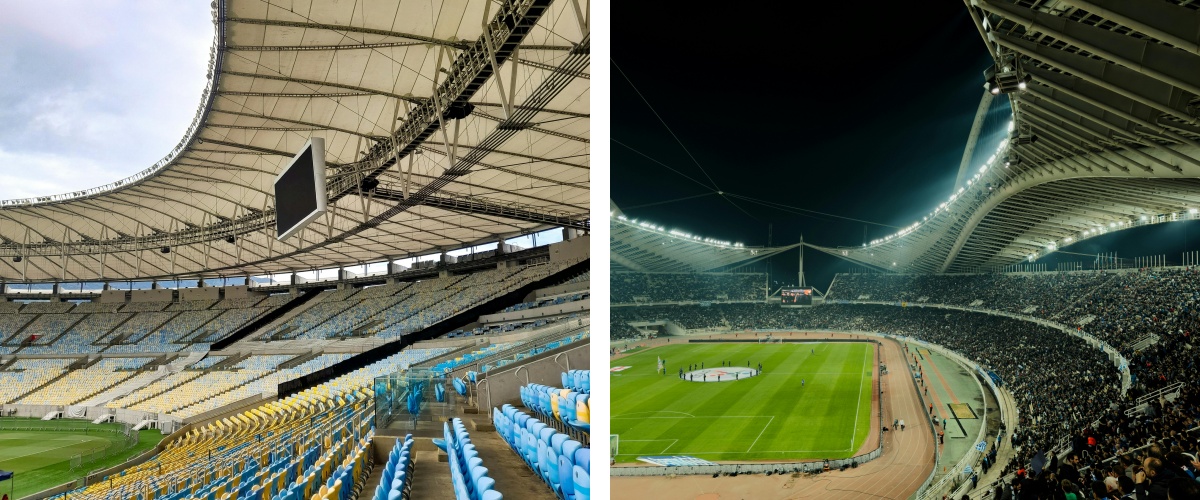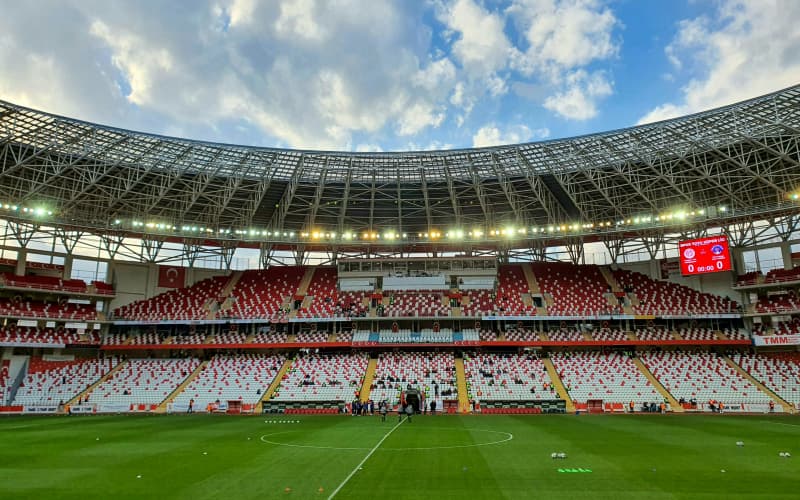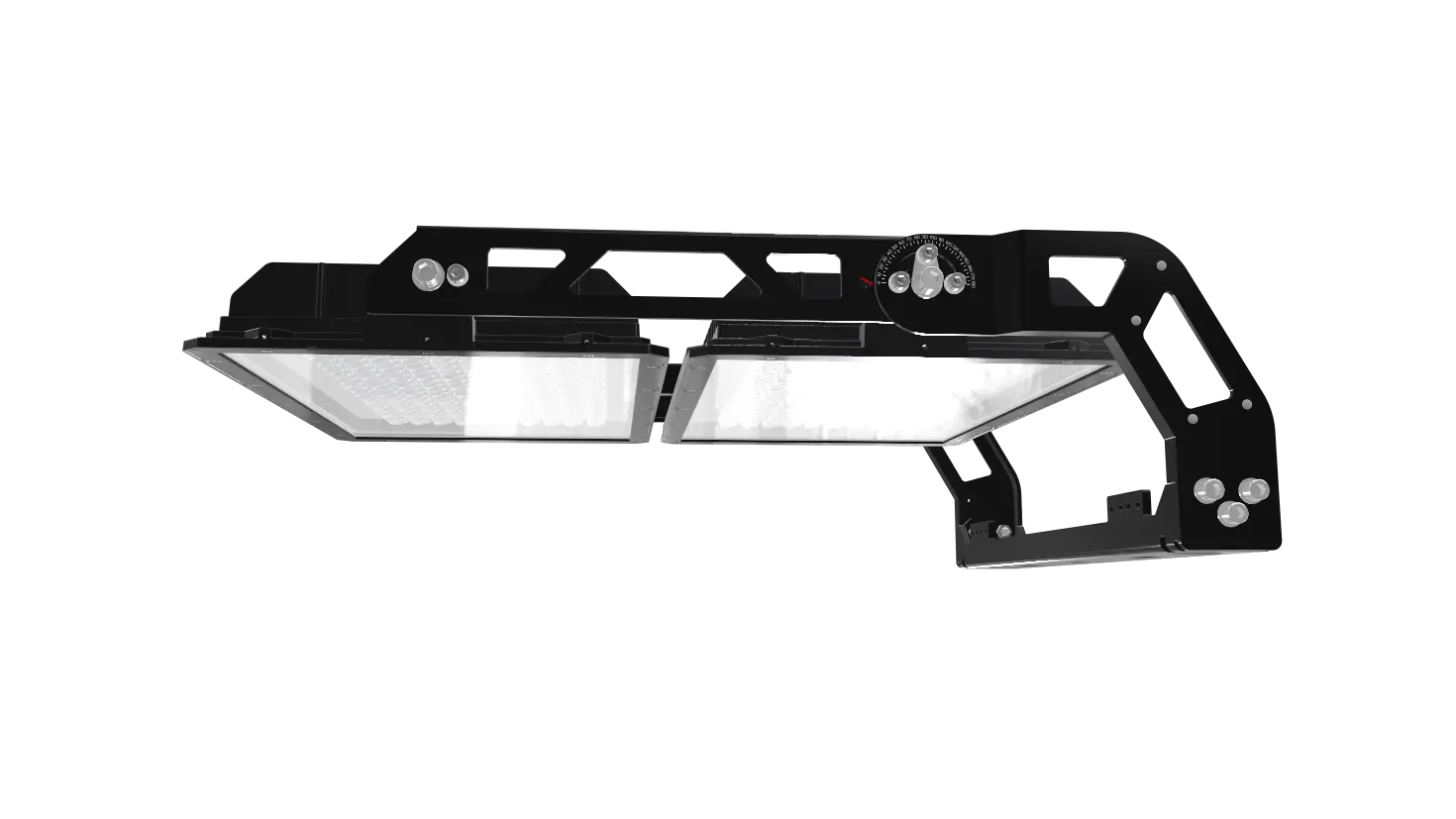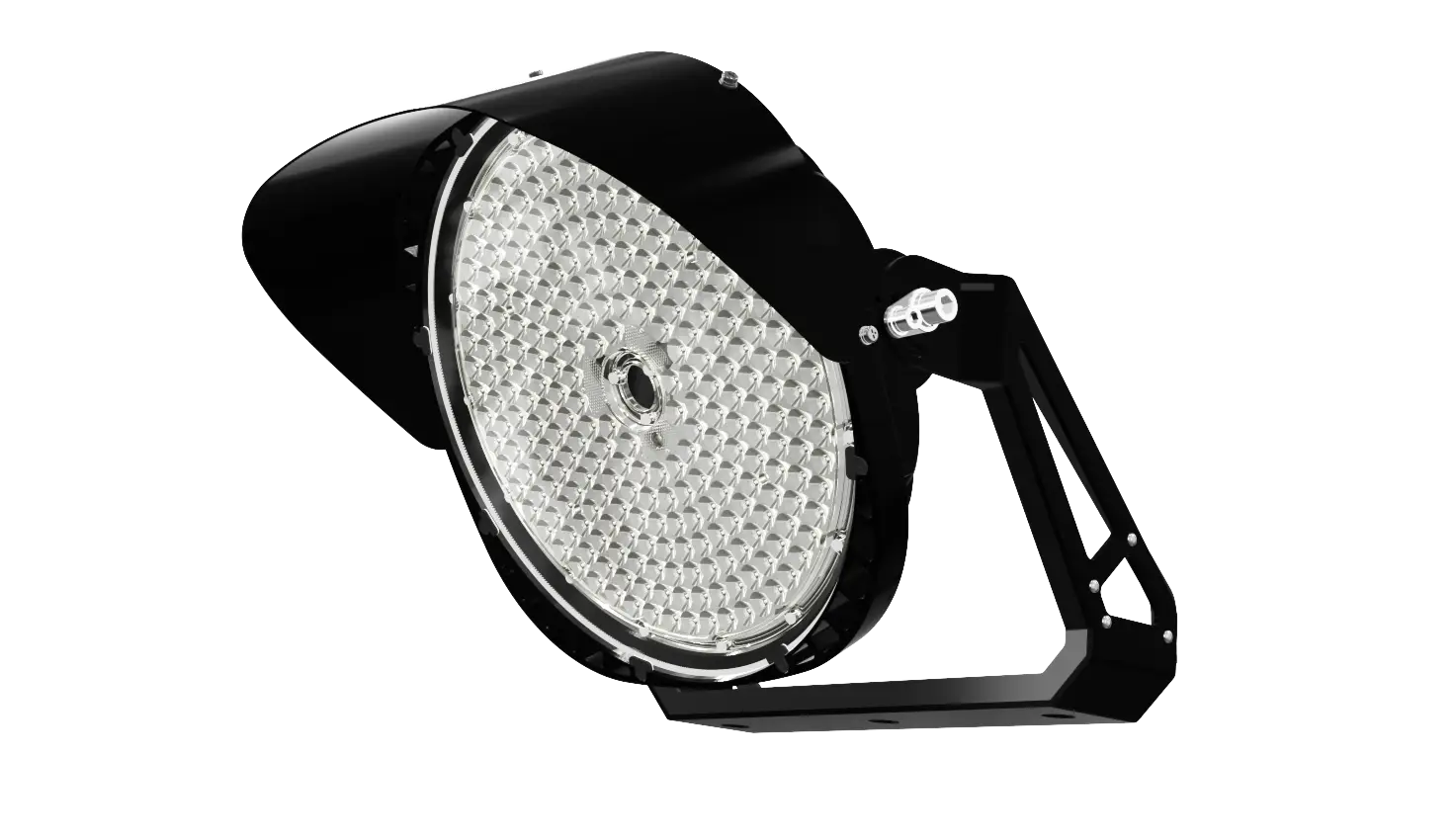Guide des éclairages LED pour stades : coûts, avantages et normes
L'éclairage est l'un des facteurs les plus importants des installations sportives modernes. Des stades professionnels aux terrains communautaires, la qualité de l'éclairage influence directement la performance des joueurs et l'expérience des supporters.
Les luminaires HID traditionnels comme les halogénures métalliques et le sodium haute pression sont depuis longtemps la norme, mais leurs limites en termes d'efficacité énergétique, de précision des couleurs et de coûts de maintenance deviennent de plus en plus évidentes.
C'est là que les éclairages LED pour stades entrent en jeu. Ils offrent un éclairage plus intense et plus uniforme, avec un éblouissement réduit, tout en réduisant les coûts d'exploitation à long terme. Que ce soit pour le football, le baseball, le soccer ou les salles polyvalentes, les LED sont désormais le choix incontournable des exploitants de stades du monde entier.

Annuaire:
1. Que sont les éclairages de stade à LED ?
2. Principaux avantages de l'utilisation de l'éclairage LED pour les stades
3. Normes d'éclairage LED pour les stades
4. Comment l’éclairage LED du stade permet-il d’économiser de l’argent ?
5. Applications des éclairages de stade à LED
6. Comment choisir les bons éclairages LED pour le stade ?
7. Pourquoi choisir CeramicLite pour les éclairages de stade à LED ?
1. Que sont les éclairages de stade à LED ?
Les éclairages de stade à LED (abréviation de Light-Emitting Diode Stadium Lights) sont des systèmes d'éclairage spécialisés conçus spécifiquement pour les enceintes sportives. Contrairement aux éclairages traditionnels qui utilisent des filaments chauffants ou des décharges de gaz pour produire de la lumière, les éclairages à LED utilisent des puces semi-conductrices pour convertir directement l'énergie électrique en lumière visible. Cette différence technologique fondamentale leur confère des avantages uniques, parfaitement adaptés aux exigences des stades, où la luminosité, la régularité et la fiabilité sont des critères incontournables.
À la base, les éclairages LED de stade de haute qualité combinent trois composants clés :
(1) Puces LED haute luminosité : généralement constituées de matériaux en nitrure de gallium (GaN), ces puces émettent une lumière intense avec une efficacité lumineuse élevée (généralement 130 à 180 lumens par watt, lm/W), garantissant que même les plus grands stades bénéficient d'un éclairage suffisant.
(2) Systèmes avancés de dissipation de chaleur : Étant donné que les LED génèrent une chaleur minimale (par rapport aux lampes traditionnelles), mais qu'une chaleur excessive peut réduire la durée de vie, les éclairages LED haut de gamme pour les conceptions de stades comprennent des dissipateurs de chaleur en alliage d'aluminium ou des structures de dissipation de chaleur en céramique pour maintenir les puces au frais.
(3) Lentilles optiques de précision : les lentilles personnalisables (avec des angles de faisceau allant de 15° à 120°) dirigent la lumière exactement là où elle est nécessaire, qu'il s'agisse de couvrir un terrain de football de 100 mètres ou de se concentrer sur un terrain de basket-ball, évitant ainsi le gaspillage de lumière et l'éblouissement.

2. Principaux avantages de l'utilisation de l'éclairage LED pour les stades
Upgrading to LED stadium lights is not only about brighter fields—it's about transforming the entire sports experience while reducing operational costs. Here are the main advantages that make them the preferred choice for modern venues.
2.1 Energy Efficiency and Cost Reduction
Compared with traditional metal halide or HPS lamps, stadium lights LED consume up to 60–70% less electricity. This translates into massive yearly savings, especially for large stadiums running lights for hundreds of hours per season. The higher luminous efficacy (lumens per watt) ensures that less power is needed to achieve the same—or better—illumination levels.
2.2 Long Lifespan and Low Maintenance
While conventional lamps may last 3,000–10,000 hours, an LED stadium light can operate for 50,000 hours or more. Fewer replacements mean less downtime, reduced labor costs, and uninterrupted sporting schedules. For stadium operators, this long-term reliability directly improves ROI.
2.3 Better Broadcast Quality and Anti-Glare Design
Modern sports broadcasting demands flicker-free, high-quality lighting. LED stadium lights deliver stable, instant illumination with no warm-up delay, making slow-motion replays crisp and clear. Additionally, advanced optics minimize glare, enhancing player visibility and improving spectator comfort in both live and televised events.
2.4 Enhanced Flexibility and Control
Unlike traditional systems, stadium lights LED can integrate with smart control platforms. Operators can dim, program light shows, or switch lighting modes depending on the event—be it a football match, a concert, or a community gathering.
Having seen the advantages, the next step is to understand how LED lighting standards for stadiums define the right brightness, uniformity, and visual comfort for professional play.
3. LED Lighting Standards for Stadiums
When investing in LED stadium lights, it is crucial to follow international benchmarks to guarantee player safety, spectator comfort, and broadcast quality. Industry authorities like FIFA, FIBA, and CIE have established widely accepted LED lighting standards for stadiums that guide design and installation.

3.1 Recommended Illuminance Levels
Different sports require different brightness levels:
FIFA football stadiums: 500 lux for training fields, 2000 lux for HDTV broadcasting.
FIBA basketball arenas: minimum 750 lux for community play, 1500–2000 lux for professional matches.
CIE guidelines: recommend an illuminance level at least 3 times higher than the ambient light (E = 3 × environment lux).
These benchmarks ensure players see the ball clearly, referees make accurate calls, and cameras capture sharp images.
3.2 Uniformity of Light Distribution
It is not enough to achieve high brightness; the light must also be evenly spread. The uniformity ratio (U1 = Emin / Eavg) should reach at least 0.7 for professional arenas. Poor uniformity creates dark patches and glare spots, reducing performance and increasing eye strain.
3.3 Color Rendering Index (CRI)
High-quality stadium LED lights should have a CRI above 80, ideally 90+, to accurately display team colors and advertising banners. This is vital for both live spectators and TV audiences, ensuring the visual experience matches real-life colors.
3.4 Glare and UGR Limits
Glare control is a critical safety factor. CIE recommends a Unified Glare Rating (UGR) below 22 for stadium environments. Advanced lens designs in modern LED stadium lights minimize direct glare, giving athletes clearer vision and making matches more comfortable for the crowd.
With standards clarified, the next question most stadium owners ask is—beyond compliance—how do LED stadium lights save money over time? That's what we will explore in the next chapter.
4. How LED Stadium Light Helps Save Money?
Investing in LED lights stadium systems may seem costly at first, but the long-term savings far outweigh the initial expense. The financial benefits come from both direct and indirect cost reductions.
4.1 Lower Energy Consumption
Traditional metal halide and HPS lamps waste energy as heat. In contrast, LED stadium lights convert most power into visible light, cutting electricity bills by up to 70%. For large venues, this translates to tens of thousands of dollars in annual savings.
4.2 Reduced Maintenance Costs
With a lifespan exceeding 50,000 hours, LED stadium lights require far fewer replacements than halide lamps. This reduces the expense of new bulbs, labor for installation, and downtime caused by lighting failures.
4.3 Avoiding Event Disruptions
Unexpected lamp failures during games can cause delays or rescheduling, leading to lost revenue. LEDs provide instant, reliable illumination with no warm-up time, ensuring uninterrupted schedules and smoother operations.
4.4 Maximizing ROI Through Incentives
In many regions, switching to LED lights stadium solutions qualifies for government rebates or energy-efficiency subsidies. These programs accelerate payback time and improve return on investment.
Transition: Beyond cost savings, stadium owners also need to consider practical factors such as installation speed and project timelines. That's the focus of the next chapter.
5. Applications of LED Stadium Lights
The versatility of LED stadium lights makes them suitable for nearly every type of sports facility and event space. From professional arenas to community venues, their performance ensures both athletes and audiences get the best experience.

5.1 Football and Soccer Fields
LED football stadium lights are designed to deliver high lux levels, wide beam angles, and uniform coverage. They meet FIFA standards for international matches, ensuring clear visibility for players and broadcast cameras.
5.2 Basketball Arenas and Indoor Gyms
Basketball requires quick movement recognition and accurate color rendering. LED lighting ensures high CRI for better visibility of the ball, court markings, and team jerseys, improving both gameplay and spectator enjoyment.
5.3 Athletics Tracks and Multi-Sport Fields
Athletics venues need consistent lighting across large areas. LED floodlights offer precise beam control, minimizing shadows on tracks and field events like javelin, high jump, and discus.
5.4 Baseball Fields
Baseball demands vertical and horizontal illumination since the ball is small and fast-moving. LED stadium lights provide bright, uniform coverage for both the infield and outfield, reducing blind spots.
5.5 Stands, Exteriors, and Roof Installations
Beyond the playing field, LED stadium lights enhance audience comfort in stands, improve safety in parking areas, and create visual impact with roof-mounted displays or synchronized light shows during ceremonies.
Knowing where to apply lighting is only part of the decision. The next step is choosing the right specifications and models to ensure lasting performance.
6. How to Choose the Right Stadium LED Lights?
Selecting the right stadium LED lights requires more than just meeting brightness levels. Buyers need to evaluate technical parameters, durability, and suitability for their specific venue.
6.1 Core Technical Parameters
Luminous efficacy (lm/W): Determines energy efficiency. High-quality LED stadium lights deliver >130 lm/W, providing strong illumination with lower power use.
Illuminance levels: Match sport-specific standards (e.g., 2000 lux for professional football broadcasting).
Color Rendering Index (CRI): Look for CRI ≥ 80, ideally 90+, to ensure accurate colors on jerseys and advertisements.
Ingress Protection (IP rating): Outdoor installations require IP65+ to withstand rain, dust, and wind.
6.2 Types of Stadium Fixtures
Floodlights: Broad beams ideal for large football or baseball fields.
High-mast lights: Tall-pole systems for even coverage across big arenas.
Area lights: Designed for stands, concourses, and parking zones.
6.3 Certifications and After-Sales Support
When sourcing stadium LED lights, ensure compliance with UL, CE, or DLC certifications for safety and performance. A reliable supplier also provides warranties, spare parts, and quick technical support to keep venues running smoothly.
Once the right product is selected, the final step is to choose a trusted supplier with proven expertise and successful case studies.
7. Why Choose CeramicLite for LED Stadium Lights?
When it comes to high-performance LED stadium lights, choosing the right supplier is just as important as selecting the right fixture. Ceramiclite brings together advanced technology, durable engineering, and long-term reliability to deliver solutions that meet the demanding needs of modern sports venues.
7.1 Advanced Ceramic LED Technology
At the core of every Ceramiclite luminaire is its proprietary FTC (transparent ceramic phosphor) material. Unlike conventional packaging, FTC offers superior thermal stability, excellent lumen maintenance, and resistance to sulfur, ammonia, acids, and alkalis. This means brighter, more reliable lighting even under extreme conditions.
7.2 Products Designed for Performance
Ceramiclite's sports lighting range includes the SL03 and SL04 stadium lights:
Sports Light SL03: Lightweight, modular, and wind-resistant, with CRI/TLCI 90 and DALI 2.0 smart control. Ideal for football fields, baseball arenas, and community sports facilities.
Sports Light SL04: Engineered for professional arenas with opto-electrical separation, multi-protocol dimming (0–10V, DALI, DMX), advanced glare control, and seamless HID replacement options.
Both models are IP66/IK08 rated, equipped with 20KV surge protection, and tested to last over 100,000 hours (L80B10).
7.3 Durability and Safety Assured
Ceramiclite products are designed for harsh environments. Features such as C4 anti-corrosion, bird-proof cabling, and dual-layer lens protection ensure consistent performance in outdoor stadiums, coastal regions, and high-humidity areas. International certifications like UL and CE guarantee compliance with global safety standards.
7.4 Long-Term Value
Beyond technology, Ceramiclite offers extended warranties of up to 10 years, reducing ownership costs for stadium operators. With intelligent lighting controls, venues can optimize energy use and qualify for sustainability incentives, maximizing return on investment.
With a trusted partner like Ceramiclite, stadium operators can confidently move forward, knowing they have both cutting-edge lighting and dependable long-term support. Next, let's wrap up with the key reasons why LED stadium lights are the ultimate choice for modern sports facilities.
8. Conclusion
LED Stadium Lights are more than just a replacement for traditional lamps—they deliver significant energy savings, long-term cost reduction, superior visual experience, and a practical installation cycle that fits modern stadium needs. By meeting international standards and ensuring player and spectator comfort, they have become the top choice for sports facilities worldwide.
If you are planning a new project or upgrading existing systems, now is the time to switch. Contact us today to get a tailored solution and a free quote for LED Stadium Lights.
9. FAQs
Q1: How long do LED stadium lights last?
La plupart des éclairages de stade à LED offrent une durée de vie de 50 000 à 100 000 heures, minimisant ainsi les coûts de remplacement par rapport aux lampes traditionnelles.
Q2 : Les éclairages LED pour stades de football sont-ils adaptés aux conditions météorologiques extérieures ?
Oui. Les luminaires de haute qualité bénéficient d'une protection IP65-IP67, garantissant une résistance à la pluie, à la poussière et aux variations de température.
Q3 : Les éclairages LED des stades peuvent-ils réduire l’éblouissement des joueurs et des supporters ?
Les éclairages de stade modernes respectent les normes anti-éblouissement UGR et adoptent une optique précise, garantissant confort et sécurité.
Q4 : Quelle est leur efficacité énergétique par rapport aux lampes traditionnelles ?
L’éclairage LED des stades consomme 50 à 70 % d’énergie en moins, avec un rendement lumineux par watt plus élevé.
Q5 : Combien de temps faut-il pour installer un éclairage de stade à LED ?
Généralement de quelques jours à quelques semaines, selon la taille du stade, la hauteur du poteau et la complexité du câblage.
Q6 : Les éclairages de stade à LED répondent-ils aux normes internationales ?
Oui, les meilleures solutions sont conformes aux normes d’éclairage FIFA, FIBA et CIE, couvrant la luminosité, l’uniformité et le rendu des couleurs.
Produit connexe
_thumb.jpg)

